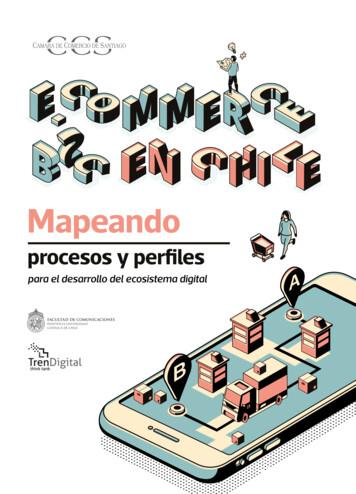GORILLA GROUP B2B ECOMMERCE BENCHMARKING
GORILLA GROUP B2B ECOMMERCEBENCHMARKING REPORTThird EditionA Smarter Species of Commerce111 West Jackson Blvd., Suite 300, Chicago, Illinois 60604 USA 1 312 243 8777gorillagroup.com
1 Gorilla Group: B2B Ecommerce Benchmarking ReportINTRODUCTIONSince sharing annual Benchmarking reports for the past two years, the B2B markethas continued to evolve alongside shifting digital trends and best practices. Manyof those developing practices indicate a broader, industry-wide focus on customerexperience-oriented engagements. As ecommerce transitions into a preferred buyingmethod for business-to-business companies in many industries, and organizationscontinue to invest significantly in their online channels, certain digital trends haveemerged, including the shift away from in-house platforms and the rising importanceof user experience-driven features and functionality.In an effort to present updated information, and compare data year-over-year, we’vecircled back with the companies researched and featured in our 2015 and 2016reports (as well as several additions based on industry changes) to create amerchant-side survey that presents a fresh look at the trends, best practices and datadriving B2B ecommerce in 2018 and beyond.
2 Gorilla Group: B2B Ecommerce Benchmarking ReportBRAND, RETAILER OR BOTH?Brand:41.0%Retailer:28.0%Both:31.0%Analysis: Similar to past years’ reports, we surveyed a mix of B2B sites, the majoritybeing brands. We characterize brands as manufacturers of their own products, selling ina B2B capacity, while retailers could be selling multiple brands or acting as distributor.For instance, Grainger is a B2B retailer and sells a number of B2B brands, such as GeneralElectric and Stanley Black & Decker. We are also noticing brand manufacturers allowingfor cross-pollination of products from partners and dealers, such as medical devicemanufacturer and distributor SPS Co. selling prosthetic limbs and other devices froma number of different suppliers at www.spsco.com. This cross-pollination can lead toincreased visibility but also serves to increase competition.PHYSICAL LOCATIONSPhysical storefront locations:31.0%Pure play etailers:68.0%N/A:1.0%Analysis: For the purposes of this year’s research, we categorize physical locations asstorefronts that facilitate actual B2B transactions, and have excluded manufacturingfacilities from the data. With this in mind, the majority of the B2B businesses surveyedare pure-play etailers, selling their products only online. This data logically aligns withthe nature of how typical B2B product categories can be sold. For instance, it’s simplerand more cost-effective for a construction site manager to order and have a large pieceof machinery and several replacement parts delivered in one bulk shipment than topick the items up at a storefront.ENABLING DIGITAL FOR B2C AND B2B AUDIENCES, ALONGSIDE EACH OTHERMany traditionally B2C brands and businesses also have significant B2B audiencesthat need to be addressed with the same care and focus given to consumer buyers.Engaging two buyer audiences (consumers as well as wholesalers/businesses)has become a key priority for many companies. For instance, an emerging brandfounded in 2013, RXBAR makes whole food protein bars with simple ingredientsthat contain no soy, gluten or dairy, with a direct and upfront approach tobranding. In addition to leveraging their digital channel to encourage direct-toconsumer sales, activating and engaging certain B2B sellers, such as gyms, yogastudios and small, gourmet grocers, was a key priority for the RXBAR team. To thatend, the brand established a separate, easily navigable website section for theirWholesale Program with a prominent tab on their homepage that leads to alanding page with details about the program and testimonials from B2B sellers. Forpotential wholesalers, a quick, step-by-step registration portal allows for a simpleand straightforward introduction to selling.
3 Gorilla Group: B2B Ecommerce Benchmarking ReportPLATFORMIn House:47.4%Magento:20.5%NetSuite:10.3%SAP Hybris:6.4%IBM:6.4%BV Commerce, Oracle,Yahoo Store, WooCommerce,Workarea, Commerce Server,Cart FunctionalityAnalysis: Since conducting our first research report two years ago, the number of B2Bsites built on in-house commerce platforms has dropped from 63% in 2015 to just47% this year. The remainder were spread across a variety of “packaged” enterprisecommerce solutions, with Magento, SAP Hybris and NetSuite leading the pack. BothMagento and SAP Hybris have committed to continually enhancing their B2Bcapabilities, and those commitments have paid dividends, with both platforms highlyranked by independent research firms. Specifically, Magento was positioned as aLeader in Forrester’s Mid-Market B2B Report, and Hybris ranked as a Leader in theLarge Enterprise Report. 1.0% eachRESPONSIVE DESIGNFeatures Responsive Design Interface:2017:75.0%2016:50.0%Analysis: Last year, the responsive vs. non-responsive split had reached 50/50. Thisyear, the number of sites leveraging responsive design has increased to 75% as B2Bsites continue to enhance their digital channels to keep pace with their B2C counterpartsthrough consumer-like experiences and best practices.Traditionally, B2B companies have been laggards to adapting B2C best practices,but Gorilla anticipates progressive web apps (PWAs) will be strongly considered forimplementation by B2B companies given their ability to provide a more fluid, applike browsing experience, which is very important for complex B2B products thatfeature highly configurable components. For more information about PWAs and futurechallenges and opportunities, listen to a recording of a joint webinar featuring Gorilla,Magento and Mobify.ACCOUNT REGISTRATIONInstant:71.8%Curated(requires site owner approval)24.4%No online commercevia account capabilities3.8%Analysis: Year-over-year, fewer sites have curated account registration systems (thatrequire site owner approval) in place. These curated registrations tend to be morecommon in B2B selling environments due to the nature of the products sold as well asthe delicate nature of displaying pricing publicly. The shift away mirrors the trend ofB2B digital experiences aligning more closely with B2C best practices. The reduction incurated registration may also be due to B2B businesses finding other ways to restrictsales of certain products through filters and user guidance.
4 Gorilla Group: B2B Ecommerce Benchmarking ReportUSER EXPERIENCEPercentage of sites offeringkey UX functionality:60 40 J51 49 J40 60 J31 69 J60.3%Cross-sells / up-sells51.3%Newsletter sign-up promotion39.7%Product ratings and reviews30.8%Quick order / re-orderfunctionalityAnalysis: As previously discussed in this report, B2B businesses continue to adoptB2C best practices to appeal to consumers, streamline site browsing and increaseengagement and purchase volume. This trend is validated upon closer examination ofthe UX best practices outlined in the sidebar to the left. B2B businesses are beginningto embrace user-generated content like product ratings and reviews, and are working tosimplify the purchase funnel through cross-sells and quick order functionality. Despitereports of decreasing effectiveness in the B2C channels we surveyed, the number ofbusinesses offering newsletter sign-up functionality has remained relatively consistentyear-over-year, which could be linked to the increasing prevalence of B2B marketingplatforms like Marketo, HubSpot and Act-On which make email marketing messagingautomated and easier than ever.PRICING PRIOR TO LOGINShow pricing prior:71.8%Do not show pricing prior:25.6%No online commerce capabilities25 —B2B2CB2BB2B2C2.6%Analysis: The number of businesses surveyed that show pricing prior to login hasremained the same year-over-year, at just more than 70%. Based on our understandingof trends and customer expectations, we predict that number will rise in the comingyears as B2B buyers mandate transparency and an immediate view of all productinformation to simplify the shopping path. However, certain retailers selling wholesaleproducts at tiered or otherwise variable prices to select customers may continue to gatetheir pricing. For those sellers, we recommend focusing on other ways of increasingcommunication and transparency by displaying price ranges or “starting at” pricing,while encouraging users to interact with the sales team for personalized guidance.The business to business to consumer (B2B2C) ecommerce model involvesbusinesses selling to other businesses, who in turn sell to consumers. The model isnot necessarily a new concept, as industries such as jewelry, multi-level-marketing(MLM), and health products have utilized this for years to distribute products. Ithas however, become increasingly popular with digital commerce platforms byallowing businesses to “spin up” individual storefronts for their sellers to purchaseproduct from the corporate entity and sell to the end customer. This enables saleschannels that, in theory, work seamlessly with consumers’ buying habits. Forinstance, one of the largest manufacturers of metal products for the non-residentialconstruction industry has a long-term strategy involving using their B2B sites toact as a foundation for branded channels for contractors selling to end consumers.These B2B2C channels will operate within the corporate ecommerce instance, withstorefronts spun off to allow for the contractors to have their own branding,contact information, product assortment and pricing information. This approach isbeneficial for the manufacturer to be able to control the entire supply and demandchain through to the end customer, while keeping their IT costs of creating newstorefronts low.
5 Gorilla Group: B2B Ecommerce Benchmarking ReportCLICK TO CHATOffer click-to-chat:201728.2%201644.9%Analysis: While click-to-chat (or livechat) functionality appears to have dropped slightlyyear-over-year, a simple technology development could explain the downward trend. Asbusinesses reduce the use of livechat features, they may be introducing chatbots that areproactive, rather than relying on reactive buttons on the site. Chatbots boast streamlinedand advanced problem-solving abilities and could be embedded in FAQ or customerservices site pages. While nothing can replace a human-human interaction, chatbots aremore cost-effective, quick to respond and can easily address commonly asked questions.Chatbots can also act as a filter for more complex concerns and route them along to anactual customer service agent.SELLER ON AMAZON BUSINESSYes:51.3%No:48.7%Analysis: Similar to last years’ data, we found that of the B2B companies surveyed,there was a nearly 50/50 split of those selling vs. not selling on Amazon Business. The‘Amazon Effect’ has been felt in almost every retail category, and the ecommerce giant’slatest push into the grocery market through their acquisition of eco-minded grocerychain, Whole Foods Market, has sent shockwaves through the food and beverageindustry. As Amazon finds strong footholds in a variety of industries, businesses thathave partnered with the ecommerce conglomerate are finding that in addition toincreased market exposure, they are also encountering reduced margins, pricing pressureand lack of critical purchaser data.Top 3 Industries/Verticals for Companies on Amazon:1) Light Industrial & Scientific2) Tools & Home Improvement3) Home & KitchenTop 3 Industries/Verticals for Companies Not on Amazon:1) Heavy Industrial2) Home Appliances & Furniture3) Food & Drugs
6 Gorilla Group: B2B Ecommerce Benchmarking ReportPRODUCTS SOLD THROUGH A THIRD PARTYYes:28.2%No:25.6%N/A:46.2%Analysis: Our research found that less than a third of B2B manufacturers surveyeddistribute their products through third party sellers, such as dealers on Amazon.For many B2B businesses, third party sellers aren’t able to provide the same level ofservice and transparency that customers are accustomed to and require. For instance,heavy industrial and manufacturing businesses often deliver custom quotes throughCPQ (Configure-Price-Quote), and offer specialized services to deliver and installcomponents. Further, certain industries sell products that require close monitoring tomaintain brand integrity and product quality. Brands in the luxury and health & beautyindustries are increasingly unlikely to sell through third party distributors due to thelack of restrictions and regulations that protect against counterfeit goods.CONCLUSIONSince our first two Benchmarking reports were released in 2015, the B2B market hascontinued to evolve to keep pace with digital trends and best practices. For themajority of manufacturers and distributors, their ecommerce channels will remaindistinct from those of their B2C counterparts due to the varying goals and businessobjectives of B2B and B2C customers. Still, there have been a number of changeswithin the B2B ecommerce market that indicate a larger shift to technology and userexperience-driven engagements.These changes include: Increased adoption of responsive design as a web best practice Enhanced focus on user-generated content and a simplified browsingexperience Continued shift to sophisticated platforms with out of the box features andfunctionality to simplify implementationGorilla will continue to keep a close eye on the B2B landscape, and we look forwardto sharing more insights and a fresh look at the data driving ecommerce in 2018and beyond.Survey MethodologyThis report is the result of a heuristic survey of relevant merchant websites taken in Juneand July 2017. All information collected is publicly available. Information on eachmerchant’s website was accurate at the time the survey was conducted, but is subject tochange due to the iterative nature of the web.Our B2B survey is comprised of data collected from 78 wholesale distributors and brandmanufacturers taken from the 2016 Internet Retailer B2B 300, as well as a sampling ofGorilla Group clients.
GORILLA CLIENT-SIDESURVEY OF B2B BUSINESS LEADERSIn order to add context to our research, boost the comprehensiveness of our 2017 report, and better understand ourclients’ future goals, we conducted a supplemental client-side survey of B2B executives new for this year. Theresults are presented with analysis in this section.What percentage of sales do you currently transact throughyour ecommerce channel?302527.3%27.3%PERCENT2018.2%15The majority of B2B clients transact more than 50% oftheir revenue through digital channels today, howeverthere are still many stragglers slow to adopt digitalbest practices to facilitate sales.109.1%9.1%The varied results demonstrate that this B2B-specificsurvey has targeted a balanced mix of companies, withabout half transacting the majority of their sales online,and the other half transacting less than 20% online. Thissplit echoes our industry understanding that not everyorganization, B2B or otherwise, will be fully invested and‘all in’ on ecommerce as their only method of transactingorders. However, we anticipate those laggards to shifttheir online sales proportions to be more in line withwhat their digital-focused counterparts are achieving inthe coming 70%71-80% 81-90%91-100%What percent of your budget do you intend to invest inecommerce in the coming Competing corporate projects could determine digitalcommerce success or failure.501-10%11-20%21-30% 31-40%41-50%51-60%Less than 10% of survey respondents say that theyplan to dedicate more than 50% of their budget toecommerce in 2018, and none say they’ll spend morethan 60% on ecommerce investments. These resultsindicate that there are significant competing initiativesthat digital commerce executives are taking note of andfocusing their attention on. Gorilla has noticed somecompanies have elected to delay ecommerce projectsdue to other capital expenditures (such as building anew fulfillment center) or IT infrastructure (such asreplatforming their ERP system). These results indicatethat there are significant competing initiatives that arecapturing the attention of digital commerce executives.61-70%71-80%81-90% 91-100%
In 2018, ecommerce investments will be allocated to whichof the following areas?MarketingFunctionsInfrastructureOperations &Sales Resources82%82%18%According to the B2B business leaders surveyed, ITand Marketing departments will continue to fight forecommerce project budget allocation. For thepurposes of this survey, Marketing can be defined asinitiatives, typically front-end-focused, that drive usersand revenue through the system. IT expenses andinitiatives can be identified as integrations, scaling and“keeping the lights on” maintenance of existingapplications. In order to reconcile these competingforces, Gorilla recommends establishing a digitaltransformation committee with members of bothteams to ensure all voices are being heard.IT and Marketing teams should work together toestablish a joint digital transformation “committee”to avoid competing for budget and resources.Whether you are selling in a B2C or B2B capacity,there’s a person at the end of every transaction.Knowing who they are and what motivates theirpurchase decisions is critical to effectively meetingtheir needs, and there remains a great opportunity inthe B2B space to effectively market and sell to buyerswith a UX-centered approach. Our results indicatethat for most survey respondents, Content &Marketing and Personalization fall squarely at the topof their investment priorities. This echoes ourexpectations, and the driving force behind the creationof our recent whitepaper, The Continued Evolution ofB2B Ecommerce: Customer Experience Management,which discusses how B2B companies that haveimplemented ecommerce are now looking to furthermonetize and drive revenue through the channel withcontent and personalization.Which ecommerce channel initiatives do you plan to investin in 2018? (Check all that apply)Content& Marketing91%Personalization73%Platform Upgrades& Selection64%Data Cleansing& 06080100PERCENTHow important is social media to your ecommerce strategy?Very Important55%Important27%Slightly Important18%Not Important At All0%Content can draw new customers and capture morerevenue from existing B2B buyers.More than 80% of survey respondents indicated thatsocial media is important or very important. Theseresults signal that traditional direct-to-consumermarketing vehicles and initiatives, like engaging socialmedia channels, should not be ignored for B2Baudiences. However, certain traditional engagementtechniques might not be well-suited for your businessoriented audience. For that reason, Gorillarecommends researching and examining social mediabest practices, and, over time, tweaking them to besttarget your B2B audience.B2B companies should not ignore social channels,but should tweak best practices to align with abusiness-oriented audience.
B2B DIGITAL COMMERCE ADVICEFROM A PRACTITIONER:Bosch USA Digital Project Manager,Sunny MallavarapuDecode the complexities of your user personas “It’s no longer just a professional user and a DIY user. There is the person who enters the orders, and all theyare concerned about is entering orders. And then there is the user who cares about promotional content tounderstand what they should be talking to sales rep about. That user doesn’t care at all about orders. There’sanother user that doesn’t care about orders or promotional data, but they’re concerned with just productinformation."Avoid tunnel vision when implementing B2C-like features and functionality for yourB2B business. Understand your customers first. “In certain cases you do not have to follow the mantra of sleek B2C practices to have a functional B2Bexperience. As mentioned, certain user personas are purchasers that need to purchase a pre-approvedset of products regardless of the experience and move on with their daily tasks. For this group, siteperformance and simplicity with minimal marketing content is optimal.”Be prepared for Amazon to rapidly change their environment, policies, procedures,and protect your business with your own well-established digital platform. “If you use Amazon as a sales channel Amazon is notorious for making quick decisions and changes,and businesses are forced to pivot.”“B2B is definitely changing for us. We started with B2B initiatives that focused on lead generationand customer buying portals. Now we’re more focused on marketing platforms. It's no longer aplatform to support a customer service need, but a touchpoint on how we engage our customers.”Understand the global implications of your digital initiatives. “For as much as we have to think globally, we now have to also start thinking very regionally. TheGeneral Data Protection Regulation (GDPR) is going to be a significant change in companiesleveraging, or planning to leverage, a global digital architecture.""Due to European-based data protocols the idea of a global platform may become increasingly moredifficult as privacy requirements with European digital properties may be different and contradictory toUS law.”
B2B digital experiences aligning more closely with B2C best practices. The reduction in curated registration may also be due to B2B businesses finding3.8% other ways to restrict sales of certain products through filters and user guidance. PLATFORM RESPONSIVE DESIGN ACCOUNT REGISTRATION 24.4% Instant: Curated (requires site owner approval)
Gorilla Ball batting cages is a 15,000 square foot outdoor batting cage facility, located in the heart of Orlando, Florida. Gorilla Ball features ten individual baseball/softball batting cages, each equipped with an automatic, token initiated pitching machine. The Gorilla Ball Pro Shop will offer patrons Gorilla
Corning Gorilla Glass Logo — Colors — GG_GLASS_PRIMARy The Primary, Secondary, and Square Corning Gorilla Glass logos are available in three colors: Black, Corning Blue (PMS 301), and White. Because of its association with the color of a gorilla and the toughness that conveys, Black is the standard color for Corning Gorilla Glass.
Cleo Jeans B2B 839 H Communion Collection (The) RC 721 Coolman Trading B2B 243 Cooper & Nelson RC 305 Copen Sportswear B2B 443 CounterattackB2B 726 H Cre Brand B2B 730 Culture Jeanswear B2B 931 D-LUX B2B 338 D’Italia RC 1315 Daniel Ellissa RC 100 H Darring VIA 1009 David X RC 609 Deals Wholesale B2B 935 & 938
B2B Marketing magazine subscription. › Annual events for B2B marketers: B2B Marketing Ignite USA and the B2B Marketing US Awards Go to b2bmarketing.net to find out more About B2B Marketing. Get in touch Alex Burton Customer care manager E: alex.burton@b2bmarketing.net T: 44 (0)20 7014 4920 B2B Marketing
1. Economía digital y comercio electrónico ¿Por qué adoptar eCommerce? Desafíos y barreras del eCommerce Tipos de relación y modelos de eCommerce 2. Mapeando el eCommerce B2C en Chile Errores más frecuentes en el mundo eCommerce Impacto, tendencias y algunas consideraciones por industria (Desde la visión de profesionales) 3.
VTEX is the gateway to the fastest-growing ecommerce market in the world Source: eMarketer; Insider Intelligence Ecommerce Penetration 11% 14% 3% 14% 29% 19% 11% 3.2T in 5 years 3.7T in 10 years Worldwide retail ecommerce sales ( trillion) Ecommerce Growth (2021) Ecommerce is accelerating globally VTEX is leading ecommerce in LatAm
k-ecommerce is mdf commerce's platform for SMBs, providing all-in-one ecommerce and digital payment solutions integrated to Microsoft Dynamics and SAP Business One. k-ecommerce simplifies and accelerates online growth, offering a complete omnichannel ecommerce solution supporting both B2B and B2C engagement. Strengthening our market position
2.1 ASTM --Standards:3 C125 Terminology Relating to Concrete and Concrete Ag- ates - ,, ,, , ,, greg- C138/C138M Test Method for Density (Unit Weight), Yield, and Air Content (Gravimetric) of Concrete C143/C143M Test Method for Slump of Hydraulic-Cement Concrete C172/C172M Practice for Sampling Freshly Mixed Con- ,, ,, , , , , , ,--crete C173/C173M Test Method for Air Content of .























